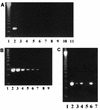Prospective study to determine clinical relevance of detection of pneumococcal DNA in sera of children by PCR
- PMID: 9508293
- PMCID: PMC104606
- DOI: 10.1128/JCM.36.3.669-673.1998
Prospective study to determine clinical relevance of detection of pneumococcal DNA in sera of children by PCR
Abstract
We undertook a prospective study to evaluate the accuracy of PCR of serum (aimed at the pneumococcal pneumolysin gene) at detecting pneumococcal infections in infants and children. The assay was positive for all blood and cerebrospinal fluid culture-positive samples and for 38 and 44% of patients with lobar pneumonia and acute otitis media, respectively. It was positive for 17% of healthy controls. There was a marked effect of age on the rate of positivity among healthy controls, with the highest rate (33%) being in 2-year-old children, the age group with the highest rate of nasopharyngeal (NP) carriage; the lowest rate was found among infants <2 months of age (13%) and adults ages 18 to 50 years (0%), age groups with the lowest NP pneumococcal carriage rates. Carriers of pneumococci in the nasopharynges had a higher rate of positivity than noncarriers of pneumococci in the nasopharynges for all groups. Our results suggest that although PCR of serum is a sensitive test for the detection of Streptococcus pneumoniae in sterile fluids, its high rate of positivity for healthy controls, related to NP pneumococcal carriage, might exclude it from being useful in detecting deep-seated pneumococcal infections.
Figures




References
-
- Appelbaum P C. Antimicrobial resistance in Streptococcus pneumoniae: an overview. Clin Infect Dis. 1992;15:77–83. - PubMed
-
- Dagan R, Abramson O, Leibovitz E, Lang R, Goshen S, Greenberg D, Yagupsky P, Leiberman A, Fliss D. Impaired bacteriologic response to oral cephalosporins in acute otitis media caused by pneumococci with intermediate resistance to penicillin. Pediatr Infect Dis J. 1996;15:980–985. - PubMed
-
- Dagan R, Melamed R, Muallem M, Piglansky L, Greenberg D, Abramson O, Mendelman P M, Bohidar N, Yagupsky P. Reduction of nasopharyngeal carriage of pneumococci during the second year of life by a heptavalent conjugate pneumococcal vaccine. J Infect Dis. 1996;174:1271–1278. - PubMed
-
- Dagan R, Melamed R, Muallem M, Piglansky L, Yagupsky P. Nasopharyngeal colonization in southern Israel with antibiotic-resistant pneumococci during the first 2 years of life: relation to serotypes likely to be included in pneumococcal conjugate vaccines. J Infect Dis. 1996;174:1352–1355. - PubMed
MeSH terms
Substances
LinkOut - more resources
Full Text Sources
Other Literature Sources
Medical
Miscellaneous

